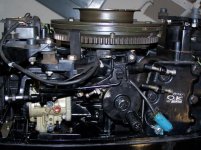Re: 40 hp high idle timing
I'm not an electronics expert but can try to give you a rundown of how Merc's T3/T4 ignitions work.
The stator is a dual function unit. It has ignition windings (bobbins) and charge coils (to charge a battery). Most "ignition" windings on Merc's are further broken into high speed and low speed windings.
The low speed side produces (high) voltage at all rpms - so they always contribute to the ignition. The high speed windings produce very low (unusable) voltage at lower rpms but are there to augment the low speed side at higher rpms when the ignition requires "more power, more often".
While these windings are located on the same (plate) the components are somewhat independant.
All these stator windings produce alternating current (AC) which is changed to DC at a follow-on component for use to either power the ignition or charge the battery.
The trigger, depending on the exact design will either have one bobbin shared by 2 cylinders or a single bobbin per cylinder. Likewise, it produces AC.
If it's a single winding shared, the positive portion of the AC signal is "chopped off" by the trigger and that "pulse" is sent to the switchbox to tell it to fire cylinder 1, then on the next pass of the magnet (normally two magnets are located on the outer ring of the flywheel so the trigger bobbin "gets passed" twice per rpm or every 180 degrees of rotation), the negative portion is cut off and sent to fire cylinder 2. If it's a single cylinder only half the signal would be used for the single cylinder.
If the trigger uses one winding per cylinder, the windings are oriented around the crankshaft at a location equivalent to the degrees of separation between cylinders, and the magnet that powers them is normally located on the inner ring of the flywheel. So on a 3 cylinder it would be every 120 degrees.
The power generated by the stators low and high speed coils is sent to the switchbox.
The switchbox contains no "servicable parts" but does contain a number of components.
There is a rectifier (to convert the AC produced by the stator into the DC that the sparkplug ultimately needs), a silicon controlled relay (SCR) - often (mistakenly) just called a switch, a Bias switch, capacitors (between 1 and 3 dependant on the number of cylinders - so a 6 cylinder would have two switchboxes configured with 3 capacitors) and blocking diodes (to make sure the power doesn't flow back to the stator). There is also a "stop circuit" which will ground all the ignition power available at the switch box if you hit the kill switch, turn off the key etc. I have probably missed a component or two but those are the major ones.
(and I apologise to the electronically inclined if my explanation is a little off - just a laymans understanding of what is going on).
So, the stator (ignition side) sends the AC to the switch box - at the switch box it passes the blocking diode to "keep it in the box" and goes to the rectifier which converts it to DC and stores it in the capacitor(s).
When the SCR get's it's AC pulse from the trigger, it "relays" to the switch telling it which cylinder needs "fire". The switch turns on the path between the capacitor and the plug coil and the bias (kinda) regulates/conditions power to keep it consistant between all cylinders. The bias is capable of regulating the power to keep it within about a 20 volt window so the power to the plugs is within a similar range so that no one cylinder gets a significantly "different power feed" than the others.
The sparkplug coil up-converts the voltage into the 45-50,000 volt range and fires the plug.
The timing is advanced or retarded (during normal operation) by mechanically moving the trigger plate by moving the windings themself to different degrees in relation to top dead center.
The AC produced by the charge side of the stator is fed to either a rectifier (which gives you un-regulated DC normally in the 13-16 volt range) or a regulator rectifier which would give you somewhat stable power for charging a battery.
That's my understanding of what is going on with the ignition on Merc's Thunderbolt 3 and 4 outboard ignitions.
(should have added)
You can tell if you have a toasted capacitor because you will have "no spark" (all else being good). The bias test will tell you if something is "sick in the box" even though it may appear to be functioning (you have spark)...


